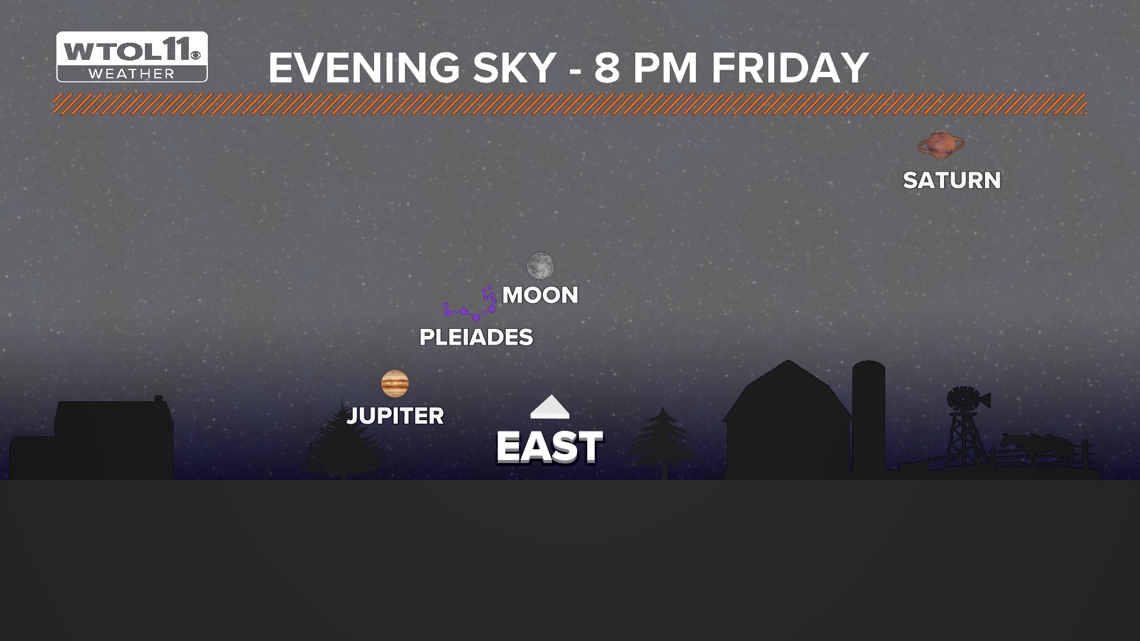TOLEDO, Ohio — Friday will mark 2024's penultimate full moon and final supermoon. Here's how and when to view it, as well as a few other astronomical objects you may want to keep your eye on.
The supermoon
According to NASA, a supermoon occurs when the moon's closest approach to Earth coincides with the moon's full phase. This makes the moon appear as much as 14% larger, and 30% brighter than a typical full moon.
This month's moon will appear full for about three days, before it will appear to wane Sunday morning.
The moon is, on average, 240,000 miles from Earth at any given point, but the orbit is not exact; NASA's website said the moon's distance from Earth at its closest - the perigee - is about 226,000 miles away, while at its farthest - the apogee - is roughly 251,000 miles away.
Supermoons always happen consecutively, NASA said. This full moon marks the last of 2024's supermoons, which began in August.
This month's supermoon will be visible in the east, with best viewing after sunset in the east, when the moon will be low on the horizon. As the night wears on, the moon will rise higher in the sky.
Are supermoons rare?
Supermoons are common, cosmologically speaking. They occur roughly three to four times per year, much more frequently than a blue moon, the latter of which occur about every other year. That's why the phrase "once in a blue moon" is used to refer to something uncommon.
What else is there to see in the sky?
If you were thinking the moon might not be enough of a reason to go sky watching (it is kind of cold out, after all), there are a few other celestial bodies eagerly awaiting your gaze. And they won't be too difficult to spot!
Provided there aren't too many clouds in the sky, any eager star (or planet) gazer will be met with several astronomical treats.
Jupiter
The solar system's largest planet will linger near the horizon in the early evening. Around 8 p.m., it will be visible below and to the slight left of the moon. Jupiter will appear brighter than most stars. With a telescope or a pair of binocular, you may be able to see one or two or its Galilean moons.
Saturn
Saturn, slightly less bright than Jupiter, will be "above" and to the right of the moon. It will be further above on the horizon than the moon. Again, a telescope or binoculars can be helpful in spotting Saturn's iconic rings.


The Pleiades
Just to the west of the moon is the Pleiades star cluster. Though the moon's brightness may make it difficult to see, the Pleiades are a seven-star cluster (sometimes called the Seven Sisters) that you can see with the naked eye. Looking just off to the side of the cluster may make it appear less like a smudge and more distinct in your peripheral vision. A telescope or a pair of binoculars will help you see all seven stars.
In Japan the Pleiades are known by a name with which you may be familiar: Subaru. Hence the astral-inspired logo.
Orion
Perhaps the most iconic constellation in the winter sky, Orion the Hunter will appear in full beneath the moon around 10:30 p.m. The constellation is most identifiable by its thrice-pointed diagonal belt. Orion's left arm, lifted over his head, is punctuated by the red giant star Betelgeuse. Though if you say it three times, nothing will happen. That's Beetlejuice.
The Leonids
The Leonid meteor shower will peak Sunday, with as many as 15 meteors visible per hour. However, the brightness of the full moon, visible all weekend, will make it very difficult to parse out any of the meteors. You can read more about it here.
-
Do you have photos of the moon, planets, or stars you'd like to share? Text them to 419-248-1100. Be sure to include your name and where you took the picture.

